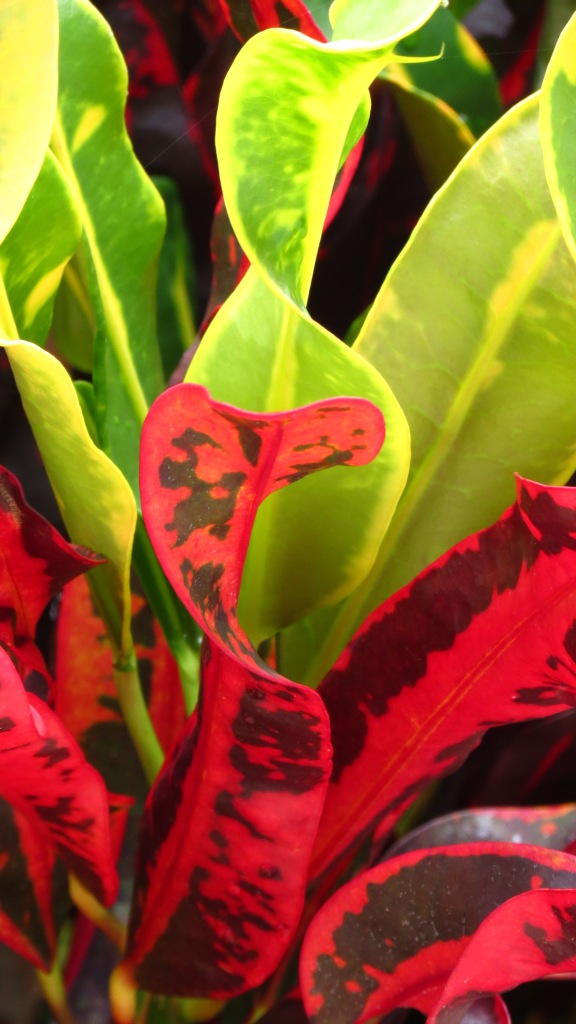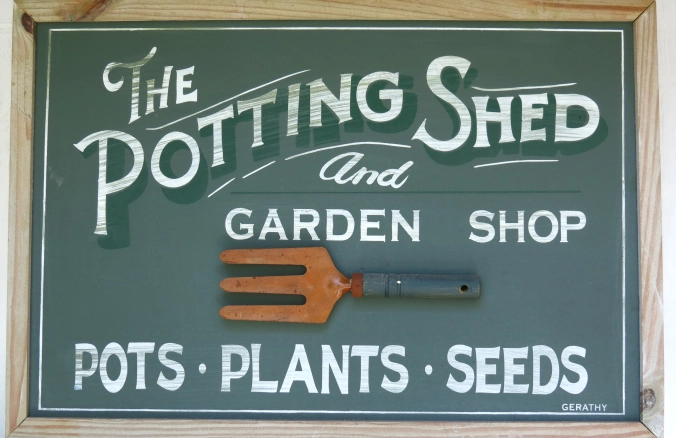This is the dilemma that’s been staring at me for some time, now. I have two orchids — one in a terra cotta pot and one in a plastic pot — and they have each made themselves very comfortable in their respective homes. In fact, they’re almost too comfortable, with their roots bursting out and over the pots.
How-To
Days Of Whine And Desert Roses
There was talk in the garden center, recently — a really juicy piece of gossip personally told to me by a customer. Now, I’m not one to gossip, but this is too huge to keep to myself . . .
Iguanas do not eat Desert Rose!
When Life Gives You Coconuts. . .
If it’s one thing I have plenty of, it’s coconuts. In my tiny yard, there are 12 coconut-producing palms — and because coconut palms are always producing coconuts, you could say that I have a lovely and large bunch of them.
But when is a coconut not a coconut?
Confessions Of A Binge Gardener
Summertime in South Florida, I’m told, is not the best time to plant or to garden. Locals often cite the high heat and high humidity — which leads to an abundance of pests and mildews.
So while gardens — and gardeners — in this hot area cool off, I’ve spent the time researching plants, dreaming up garden plans, and binge-watching television series. “Breaking Bad.” Done. “Orange Is The New Black.” Check. “Downton Abbey.” Finito.
Everything was moving along nicely until “Downton” introduced a gardener into Violet Crawley’s world, and I found myself hoping for a larger storyline for the young fellow or — even better — a spin-off. “Downton Gardens,” perhaps?
Nevertheless, as I pondered the idea of beginning a gardening program for the inmates on “Orange,” it occurred to me that I had had my fill of fictional gardens. I missed real gardening. There was a burning inside of me — as feverish as those felt by any of Walter White’s meth heads — to dig in the dirt, plant seeds, and root clippings.
So the other day, I caved in to my cravings and embarked on a binge of my very own. A garden binge, if you will.
I had been eyeing this hibiscus in the neighbor’s yard, blooming in the gap between our two houses. Each day, I’d walk by and that flower would wink its stamen at me. And since I’ve been looking for a Florida plant to take the place of hydrangeas, I wondered if I could root hibiscus the same way I was able to root my favorite shrub in my northern garden.
Out came the clippers, some cell packs, a shovel, and the rooting hormone. I did my best to clip non-bud branches, and then removed the lower leaves. The clippings were immediately placed in water to keep the stems moist.
I had also prepared the cell packs with basic garden soil and made holes in the center of each. After dipping the stems in rooting hormone, I slipped them into the pre-made holes, careful to not loosen the powdery rooting hormone. This was followed with a gentle watering, and then the small plants were placed out of direct sunlight.
Once started, though, I couldn’t get enough. I had merely had a sip of gardening and I was still achingly thirsty.
From the corner of my eye, I spotted the neighbor’s croton, a shrub with brightly colored foliage. There are many varieties of the plant, but I’m always drawn to the thin, slightly-curled leaf kind, each branch sharing green and red mottled leaves.
I again used the same rooting technique, planting up four small cuttings.
Not quite sated, I thought to myself, “If only I could dig up an actual plant, an off-shoot from a mother plant.” I crouched and crawled across the ground, lifting branches and looking beneath, sending small anoles scurrying.
Eventually, I found two small Chinese fan palms (Livistona chinensis) that had sprouted from seeds at the base of the mother tree. In time, this palm, with tiny hooks along the stems of the fronds, will reach up to 50’. Because of its slow growing habit, however, it’s often used as an understory planting.
I found the jackpot at the base of a Sunshine palm (Veitchia montgomeryana). There, seven smaller palms — resembling tall blades of grass — had sprouted. I carefully pried each one up and gave them a pot of their own.
By the end of the day, my hands and fingernails caked with dirt, my clothes and forehead soaked with sweat, I took a look at all I had done to satisfy my gardening hunger. I had quite the tally: eight hibiscus, four crotons, two Chinese fan palms, and seven Sunshine palms.
At this point, I’m not sure if any of my treasures will survive — and if they do, I’m not sure if I’ll actually use them in the landscape or give them away. I don’t think I’d sell them, though. I’m not a plant pusher. I’m a binger.
The Biggest Seed I Ever Planted
It’s seed starting time — and by now, I should have flats of impatiens and petunias and geraniums planted in my Long Island potting shed, with dahlias, cosmos, and gazanias scheduled for the weeks ahead. But as I’ve said in previous posts, this is a season of a different kind — in so many ways.
For starters, I’m away from the potting shed. Instead, I have south Florida — and as my northern garden and gardening friends have shivered and shoveled during this winter’s harshness, south Florida has enjoyed exceptional warmth. By northern standards, it feels like summer.
Repost: That’s A Wrap!
Baby, it’s cold outside. And for Joe and me, the cold temperature is our cue that it’s time to wrap our windmill palm for the winter months. So while we’re outside, I’m offering my seasonal repost of what it is that we’re doing and why.
I may be the gardener of the house, but Joe also has his landscape loves. One of his greatest is palm trees. His absolute fave is Cocos nucifera, the coconut palm. If it were up to him, coconut palms would be growing everywhere. We often joke that he would be to coconut palms what Johnny Appleseed was to apples — only he would be called Joey Coconuts, which does sound a little — alright, a lot — like a character from “The Sopranos.”
Sadly, coconut palms will not grow in our Zone. Nor will most other palms found around the world. So what’s a palm lover to do? About 10 years ago, we purchased a windmill palm, Trachycarpus fortunei to be exact, from Stokes Tropicals. Originally grown in China, the windmill is one of the hardiest of palms, able to tolerate a fairly severe freeze and a light winter snow cover.
But this is Long Island, and winters are unpredictable. Sometimes mild, sometimes snowy and frozen — and after the year we’ve had, who knows which winter will come our way. Although the palm receives full sun, there are steps that we must take — or rather Joe must take, with my assistance — to ensure winter survival.
Repost: Saving Elephant Ears & Canna, Part 2
Changing leaves and cooling temperatures can only mean one thing. It’s time to complete the saving process. By now, elephant ears and canna have been drying out for about a week — and now I have to get them ready for their long winter’s nap.
The final step is pretty much the same for both elephant ears and canna. You will need peat moss, some kind of storage containers (like brown paper bags), a shovel, and a room that stays relatively dry and evenly cool so that the plants can be lulled into a deep sleep without freezing. If the final storage location is too damp or warm, the plants never get a chance to rest and they are at risk of rotting away — and after so much work getting to this point, that would be a shame.
Repost: Saving Canna, Part 1
I’ve had to make a difficult decision this year about my collection of canna. What started with a few corms has, over the years, become an overwhelming amount of plants — even after giving corms away. And the increase in plants also means an increase in labor, and I’m reaching a point (for several reasons) where I have to cut back. So, I’ve decided to not save canna and to instead start fresh next year. In the meantime, though, I thought it was still important to repost the steps that I’ve followed to keep the canna coming.
Repost: Saving Elephant Ears, Part 1
The October weather has been strange. There was a moment when it felt like autumn, but then it became more mild and humid — and so I let my tropicals stay in the ground. But how much longer will I be able to get away with that? At some point, it will become cooler and frost will arrive — and these tropicals need to be stored for the winter.
This will be my weekend project — and since I’ll be a bit busy, I thought it was the perfect time to re-visit a previous post that chronicles the process. Up first are the elephant ears.
The House That Joe Built
Over the past few months, I have been inundated with emails about my potting shed. Most people want to know where they could purchase the same kit. When I explain that the shed is Joe’s original design, they want specifics.
So with a lot of help from Joe, here is a post that has been a long time coming. Additional photos and information can be found in “The Potting Shed” tab above.
Before there was a potting shed, there was me — on a mission to start seeds in advance of the planting season, and Joe — on a mission to reclaim the kitchen and dining room from trays and flats of new sprouts. Surveying my long and leggy seedlings, I said, “If I had a potting shed, I’d be dangerous.”
Little did I know that that sentence, a seed traveling on waves of sound, would eventually settle into one of the folds of Joe’s brain, taking root and springing into action.














